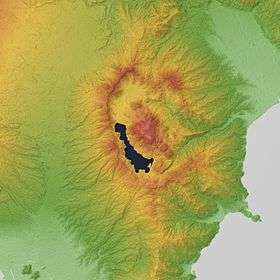Mount Hakone
| Mount Hakone | |
|---|---|
| 箱根山 | |
 Hakone Volcano (Mount Hakone) | |
| Highest point | |
| Elevation | 1,438 metres (4,718 ft) |
| Coordinates | 35°13′48″N 139°01′26″E / 35.230°N 139.024°ECoordinates: 35°13′48″N 139°01′26″E / 35.230°N 139.024°E[1] |
| Geography | |
| Location | Hakone, Kanagawa, Honshu |
| Geology | |
| Mountain type | Complex calderas |
| Last eruption | June to July 2015[2] |
Mount Hakone (箱根山 Hakoneyama) is a complex volcano in Kanagawa Prefecture, Japan that is truncated by two overlapping calderas, the largest of which is 10 × 11 km wide. The calderas were formed as a result of two major explosive eruptions about 180,000 and 49,000–60,000 years ago. Lake Ashi lies between the southwestern caldera wall and a half dozen post-caldera lava domes that arose along a southwest–northeastern trend cutting through the center of the calderas. Dome growth occurred progressively to the south, and the largest and youngest of them, Kami-yama, forms the high point of Hakone. The calderas are breached to the east by the Haya-kawa canyon. Mount Ashigara is a parasitic cone.[3]
The latest magmatic eruptive activity at Hakone occurred 2,900 years ago. It produced a pyroclastic flow and a lava dome in the explosion crater, although phreatic eruptions took place as recently as the 12–13th centuries AD.[4]


Notes
- ↑ "Hakoneyama". Global Volcanism Program. Smithsonian Institution. Retrieved 2015-05-07.
- ↑ "Hakoneyama". Global Volcanism Program. Smithsonian Institution. Retrieved 2015-05-07.
- ↑ "Hakoneyama". Global Volcanism Program. Smithsonian Institution. Retrieved 2015-05-07.
- ↑ "Hakoneyama". Global Volcanism Program. Smithsonian Institution. Retrieved 2015-05-07.
External links
| Wikimedia Commons has media related to Hakone Mountains. |
- Hakoneyama - Japan Meteorological Agency (Japanese)
- "Hakoneyama: National catalogue of the active volcanoes in Japan" (PDF). - Japan Meteorological Agency
- Hakone Volcano Group - Geological Survey of Japan
- Hakoneyama: Global Volcanism Program - Smithsonian Institution
- Hakone Geopark(Japanese)